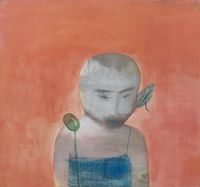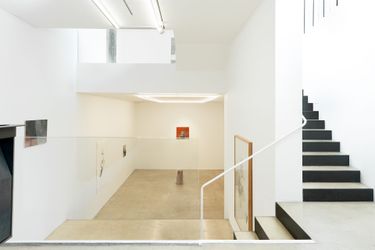
The figures drawn by Yi Soonjoo are not children nor adults. Their eyes look mischievous but their lips are barely there, all you can see is a thin line. The body is blurred. There are no gender, and humans, animals, and plants coexist without any hierarchy. By the time I had a dim memory of when I had met these beings, Yi brought out their images which I had forgotten for quite a while. More than a decade ago, we were preparing a solo show just like now. I had invited her to the artist residency which went on for a month. During that time, Yi continued to frequent the street Sungbukdong 23. At the time, she looked like sombody who had found her hometownagain. After just a couple of years since the exhibition closed, she became a proper resident of Bukjeong village in Sungbukdong. And now, she is the one who invited me back to the previous place while preparing her solo show in more than a decade. It is as if a time warp summoned me back to the past. Indeed, her drawings had piled up as much as the layers of time passed. There were also her 'children' that were sometimes introduced in exhibitions. Oh yes, many artists also call their works their children, but Yi is especially keen in doing so. Yi Soonjoo does not create for an exhibition. As in the past or currently, drawing is the same act as any of her routine chores. Anyway, there were these children whom I had seen in previous exhibitions, but old drawings that were kept intact that were generally never presented before were being pulled out as our first step for preparing the show. When Yi was showing her drawings of all sizes one by one, she looked like someone showing a friend her photo album. Drawing must be like breathing for her. Come to think of it, artists seem to generate/discharge the material and energy required for artistic activity, hence called the artistic metabolic activity. The artistic metabolism realised by Yi begins with distancing herself from the given order, conventional ideas and actions, and invisible (social) requirements. She seems to tell us to get away from the burden of meaning.
The title of the show we had created together as artist and curator more than 10 years ago was "Forgotten details knock on my door"and this is exactly what happened, asking the same question. When I reminisce about the time, I realise that Yi Soonjoo must have discovered a certain empty space between civilisation and social system while walking on the street Sungbukdong 23. The past exhibition was also an opportunity of letting her old drawings encounter the world. Yi's drawings resonate with her 'children' that are by her side. As in the past and also in the present, she tends to stay around her residing place, reaching further into near places, not travelling far out. This reflects Thoreau's praise of the walk which does not aim to reach somewhere but to remain somewhere.1 When I saw Yi's works, I was first reminded of Albert Camus' series of essays Betwixt and Between2 which is his first publication at the age of 23. With observations of the people around him, Camus frankly questions the issue of despair and love, whether they could not be compatible. The Korean translation of the book's title being Inside and Outside, it reflects Camus' intent of wanting to avoid becoming someone who is two-faced. That is to say, the inside is linked with the outside, and rather than worldly success, living the life in his place without discrimination was exactly the form of love pursued by Camus. What I love about Yi Soonjoo's drawings is that every-thing in this world is mixed together; children, adults, woman, man, plant, animal, symbol, organ, label, stain, dirt, place. The state of not having any right location, nor top or bottom. Since this peculiar world never had any hierarchy or order in the first place, anybody can be welcomed. This resonates with Camus' mindset of approaching the world by licking the outer rim between the in and out, rather than heading from inside to outside.
"I hold onto the world with every gesture, to men with all my gratitude and pity. I do not want to choose between the right and wrongsides of the world, and I do not like a choice to be made. People don't want one to be lucid and ironic."3
The current exhibition archives through her drawings, the time and space the artist had lived, and mostly her state of mind headed toward unstable and perilous life. Generally, an archive reminds us of countlessly piled up materials and a sort of order or structure to classify them. However, Yi's archive consists of her drawings and paintings that convey her thoughts, motifs, events that were drawn from her daily routine. The historian who studied archives, Arlette Farge, had metaphorically called archiving the act of peeling.4 That means, it is a work requiring an immense amount of patience which should be done very slowly. Yi's drawings look light and thin but they are executed in fact with various materials formed in thin layers. Some drawings would be filled with dirt-like stains. This is the drawing's process of maturation reflecting its time. In the artist's work, the texture, thickness, and weight of the material are quite significant. The various sizes of the drawings: a postcard, a small notebook, or even big ones that you would have to hold with both arms all have the lightness of having to hold only with your thumb and forefinger. There is no need of a standardised size. For Yi, matter is also another being and lightness is not the opposite of heaviness. They should all be understood as other beings existing differently with different characters.
Mum Mom Mam.5 This show with the title sounding like a spell being cast, proposes walking in order to fumble and approach words that existed before civilised language. To think about what our body and mind wants, what the land wants, how we are becoming monsters, why we still have to love.
1 Rebecca Solnit, Savage Dreams.
2 L'Envers et l'endroit (1937), also translated as The Wrong Side and the Right Side.
3 https://thejqcorner.wordpress.com/2021/03/30/excerpt-from-the-wrong-side-and-the-right-side-by-albert-camus/ referring to Albert Camus, Lyrical and Critical Essays, Edited by Philip Thody, Translated by Ellen Conroy Kennedy, Vintage, 1970.
4 Arlette Frage, The Allure of the Archives.
5 Phonetic notation of Korean words which result in similar pronunciations: Farness, body, mind. Therefore this title does not signify mother expressed in three different terms, but it is an interesting coincidence.
Press release courtesy ONE AND J. Gallery.
26, Apgujeong-ro 60-gil
Gangnam-gu
Seoul, 06014
South Korea
www.oneandj.com
+82 2 745 1644
+82 2 745 1642 (Fax)
Tuesday – Sunday
11am – 6pm
